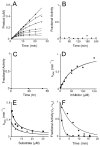Uridine-based inhibitors as new leads for antibiotics targeting Escherichia coli LpxC
- PMID: 19256534
- PMCID: PMC2709817
- DOI: 10.1021/bi900167q
Uridine-based inhibitors as new leads for antibiotics targeting Escherichia coli LpxC
Erratum in
- Biochemistry. 2009 Aug 18;48(32):7776. Hangauer, Matthew J [added]
Abstract
The UDP-3-O-(R-3-hydroxyacyl)-N-acetylglucosamine deacetylase LpxC catalyzes the committed reaction of lipid A (endotoxin) biosynthesis in Gram-negative bacteria and is a validated antibiotic target. Although several previously described compounds bind to the unique acyl chain binding passage of LpxC with high affinity, strategies to target the enzyme's UDP-binding site have not been reported. Here the identification of a series of uridine-based LpxC inhibitors is presented. The most potent examined, 1-68A, is a pH-dependent, two-step, covalent inhibitor of Escherichia coli LpxC that competes with UDP to bind the enzyme in the first step of inhibition. Compound 1-68A exhibits a K(I) of 54 muM and a maximal rate of inactivation (k(inact)) of 1.7 min(-1) at pH 7.4. Dithiothreitol, glutathione and the C207A mutant of E. coli LpxC prevent the formation of a covalent complex by 1-68A, suggesting a role for Cys-207 in inhibition. The inhibitory activity of 1-68A and a panel of synthetic analogues identified moieties necessary for inhibition. 1-68A and a 2-dehydroxy analogue, 1-68Aa, inhibit several purified LpxC orthologues. These compounds may provide new scaffolds for extension of existing LpxC-inhibiting antibiotics to target the UDP binding pocket.
Figures








Similar articles
-
Antibacterial agents that target lipid A biosynthesis in gram-negative bacteria. Inhibition of diverse UDP-3-O-(r-3-hydroxymyristoyl)-n-acetylglucosamine deacetylases by substrate analogs containing zinc binding motifs.J Biol Chem. 2000 Apr 14;275(15):11002-9. doi: 10.1074/jbc.275.15.11002. J Biol Chem. 2000. PMID: 10753902
-
Inhibition of lipid A biosynthesis as the primary mechanism of CHIR-090 antibiotic activity in Escherichia coli.Biochemistry. 2007 Mar 27;46(12):3793-802. doi: 10.1021/bi6025165. Epub 2007 Mar 3. Biochemistry. 2007. PMID: 17335290 Free PMC article.
-
N-Hydroxyformamide LpxC inhibitors, their in vivo efficacy in a mouse Escherichia coli infection model, and their safety in a rat hemodynamic assay.Bioorg Med Chem. 2020 Dec 15;28(24):115826. doi: 10.1016/j.bmc.2020.115826. Epub 2020 Oct 28. Bioorg Med Chem. 2020. PMID: 33160146
-
UDP-3-O-(R-3-hydroxymyristoyl)-N-acetylglucosamine deacetylase (LpxC) inhibitors: a new class of antibacterial agents.Curr Med Chem. 2012;19(13):2038-50. doi: 10.2174/092986712800167374. Curr Med Chem. 2012. PMID: 22414079 Review.
-
Recent Process in the Inhibitors of UDP-3-O-(R-3-hydroxyacyl)-Nacetylglucosamine Deacetylase (LpxC) Against Gram-Negative Bacteria.Mini Rev Med Chem. 2018;18(4):310-323. doi: 10.2174/1389557516666161013120253. Mini Rev Med Chem. 2018. PMID: 27739357 Review.
Cited by
-
Challenges of antibacterial discovery.Clin Microbiol Rev. 2011 Jan;24(1):71-109. doi: 10.1128/CMR.00030-10. Clin Microbiol Rev. 2011. PMID: 21233508 Free PMC article. Review.
-
Antibacterial Drug Discovery Targeting the Lipopolysaccharide Biosynthetic Enzyme LpxC.Cold Spring Harb Perspect Med. 2016 Jul 1;6(7):a025304. doi: 10.1101/cshperspect.a025304. Cold Spring Harb Perspect Med. 2016. PMID: 27235477 Free PMC article. Review.
-
The Complex Structure of Protein AaLpxC from Aquifex aeolicus with ACHN-975 Molecule Suggests an Inhibitory Mechanism at Atomic-Level against Gram-Negative Bacteria.Molecules. 2021 Mar 7;26(5):1451. doi: 10.3390/molecules26051451. Molecules. 2021. PMID: 33800069 Free PMC article.
-
Syntheses, structures and antibiotic activities of LpxC inhibitors based on the diacetylene scaffold.Bioorg Med Chem. 2011 Jan 15;19(2):852-60. doi: 10.1016/j.bmc.2010.12.017. Epub 2010 Dec 9. Bioorg Med Chem. 2011. PMID: 21194954 Free PMC article.
-
Uridine Derivatives: Synthesis, Biological Evaluation, and In Silico Studies as Antimicrobial and Anticancer Agents.Medicina (Kaunas). 2023 Jun 7;59(6):1107. doi: 10.3390/medicina59061107. Medicina (Kaunas). 2023. PMID: 37374310 Free PMC article.
References
-
- Walsh C. Molecular mechanisms that confer antibacterial drug resistance. Nature. 2000;406:775–781. - PubMed
-
- Projan SJ, Youngman PJ. Antimicrobials: new solutions badly needed. Curr Opin Microbiol. 2002;5:463–465. - PubMed
-
- Russell AD, Chopra I. Understanding antibacterial action and resistance. E. Horwood; New York: 1990.
-
- Wyckoff TJ, Raetz CRH, Jackman JE. Antibacterial and anti-inflammatory agents that target endotoxin. Trends Microbiol. 1998;6:154–159. - PubMed
Publication types
MeSH terms
Substances
Grants and funding
LinkOut - more resources
Full Text Sources
Other Literature Sources
Chemical Information
Medical
Miscellaneous

